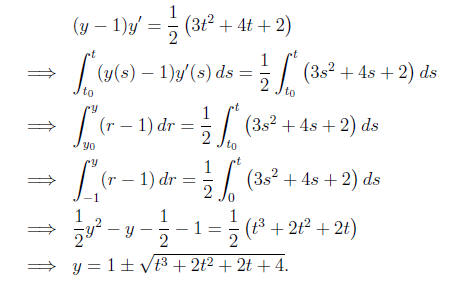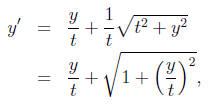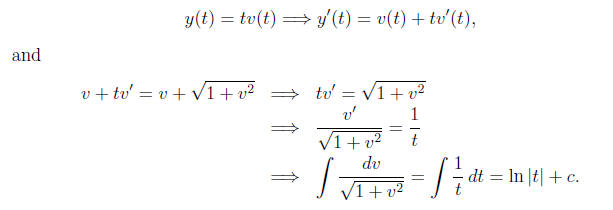MATH 3D Homework 3
Section 1.4 Problems
9. Solve the given initial value problem, and determine the interval of existence of the solution.

Solution: (15 points) This is a first-order, nonlinear problem, so we use separation of variables:

To choose the sign of the root, we note that in the expression above, y(0)
can
only be negative if the root is negative. So, the solution is

For interval of existence, we seek times tstart < t0 = 1 < ttend where the
solution
fails, such that the solution never fails on (tstart, ttend). Well, for this
solution,
the only way it can fail is by taking the square root of a negative number, so
we
find roots of

The quickest way to do this is to factor as below:

so the only real root is t = -2.
Alternatively, use the rational root theorem to guess a
first root: if there's a
rational root, it's one of  Evaluation of these
shows that -2 is a
Evaluation of these
shows that -2 is a
root, and we can factor it (by long division) to
 The other two roots are
complex. So, the solution is valid on
The other two roots are
complex. So, the solution is valid on 
15. Solve the given initial value problem.

Solution: (10 points) This is a first-order, nonlinear
problem, so we need
separation of variables. However, the problem is not immediately separable.
(When you have factors like  it's a good hint
that this is the
it's a good hint
that this is the
case.) We know that we'd eventually like to have f(y)y' = g(t), so dividing both
sides by t is a good start:

which suggests a new variable v = y/t . Then

To integrate the left side, we use a trig substitution:

Notice

and the integral is

It's easier to plug in the initial condition now:


Thus, when we plug in v = y/t and solve for y, we have

Now, notice that from the original differential equation, if y≥0 and t > 0,

So, if the solution starts at or above 0, it stays above
zero. That's the case here,
as y(1) = 0. So,

and we can solve for y:

Completeness Points
(4 points) For problems 7, 11, 17, and 19, 1/2
point per moderately-attempted problem, and another 1/2 point per
very-seriously, nearly-properly-solved problem.


